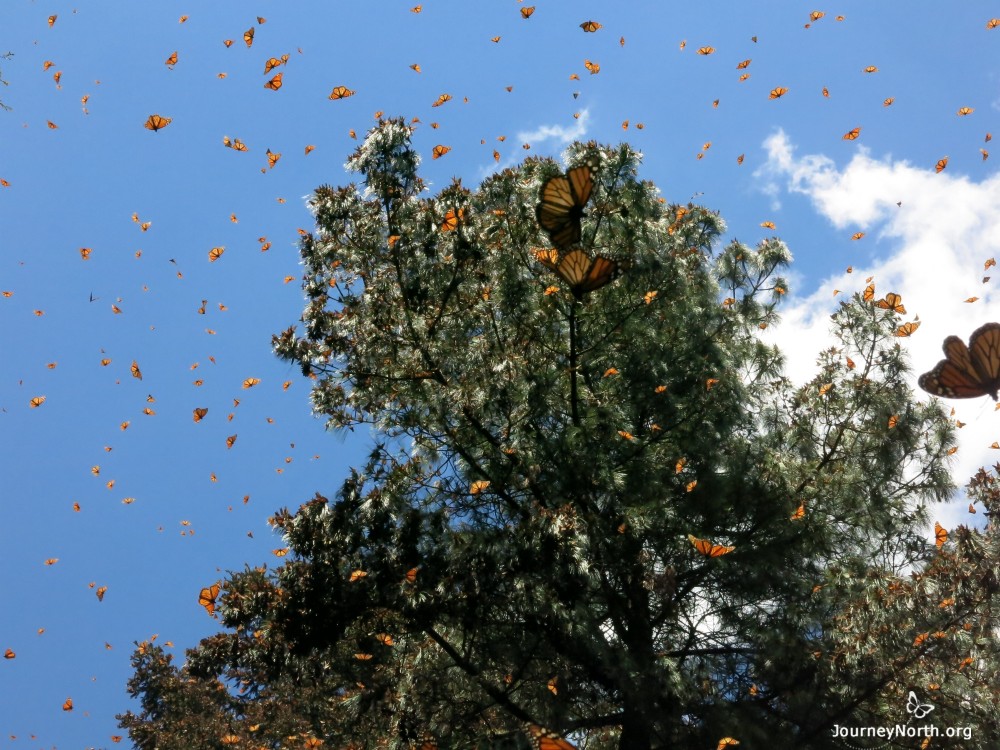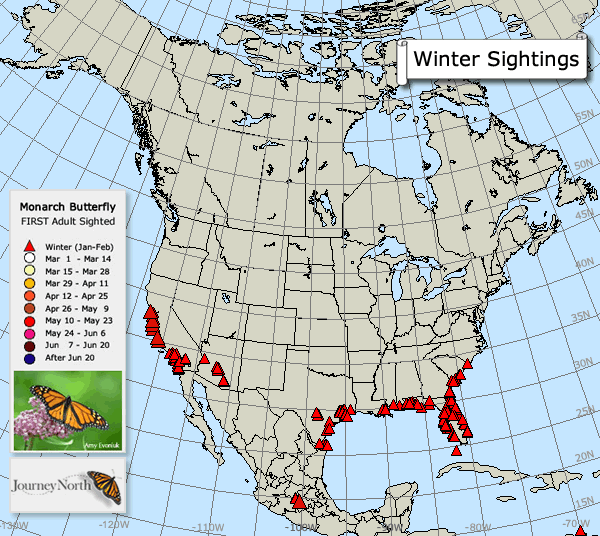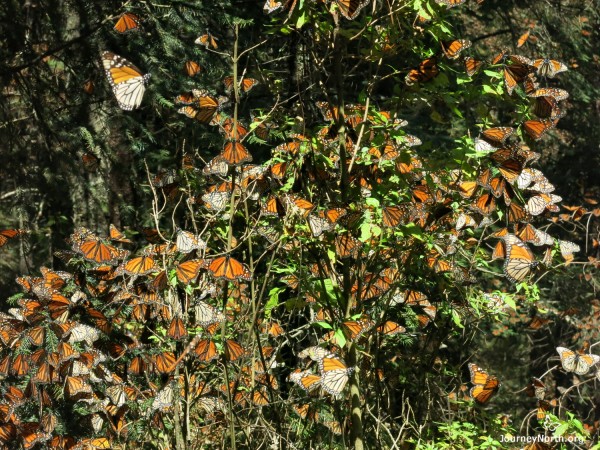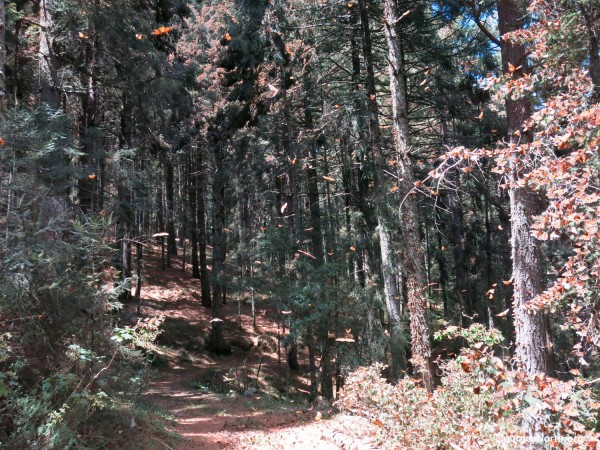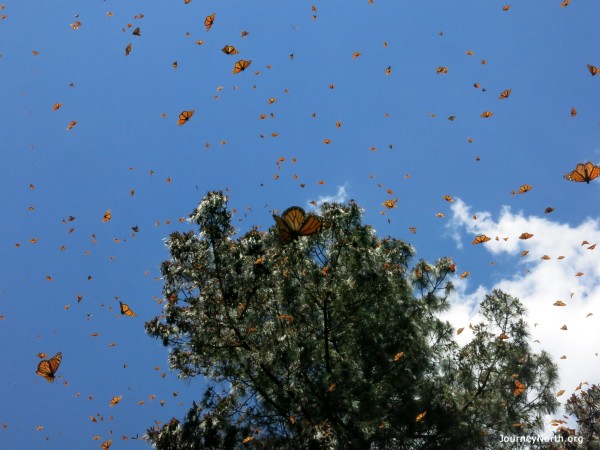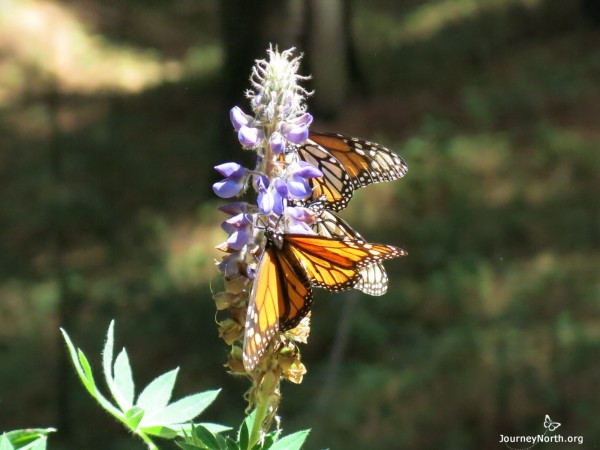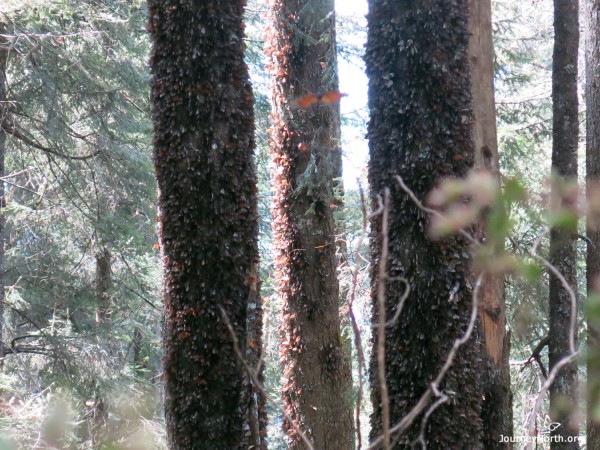Letter from Estela
Considerably Dense Population in Sierra Chincua!
Friday, March 17, 2017
Dear Friends,
Yesterday, Thursday, March 16th, lots of monarchs started to pass by over Angangueo, clearly coming from El Rosario, and definately flying northwards. This made me hurry up my way to Sierra Chincua today, lest the massive leaving could be occurring there too!
This is the same colony that I visited last Tuesday, March 14 when I accessed it through Senguio town. This time, I went the traditional way from Sierra Chincua’s public entrance. The site is called “Koala” and is on land owned by Senguio Ejido.
On arriving, the guide, Nicolás Díaz, Ejidatario from the Ejido Los Remedios, explained to me (his argument absolutely matching the testimony of the guides in Senguio last Tuesday):
“This high population, which has been the core of the Colony over the whole season, arrived and settled here, at the “Koala” site, belonging to the Senguio Ejido, since the very first days when monarchs first arrived this season. They have continued here up to now as the main colony. The other colony, opened to visitors up there at “Llano Redondo,” also had a very good population over the season, and still does, as you will see,”, he proudly assured to me.
At the Very Core of the Koala Colony
It took us around 30 minutes horse-riding and another 30 minutes walking to reach the “Koala” site. On arriving, the core of the colony was indeed there. I was surprised to see a very considerable population remaining. The weather seems to be one of the optimal factors keeping, what I would consider to be right below half of the wonderful density of the colony a couple of weeks ago, which means that a little more than half should have already left by now.
Monarchs were everywhere around a perimeter of about 40 trees. They were as active and noisy as if one had been really near to a beehive. The performance is still overwhelming to this day of the month! There were a fair number (not abundant) perishing on ground. Mating was scarce.
After staying here for some minutes amazed at the wonderful performance, my guide and I started our way back up towards “Llano Redondo”, where the smaller colony is.
The Smaller Colony at "Llano Redondo"
On our way up to the site as we walked over the main road, we were running into lots of monarchs flying against us and northwards as if in direction to the main colony:
“You see, all of these monarchs are now leaving the smaller colony above us and, many may be joining the main colony, but many others should be now directly flying over Senguio Ejido and Municipality, on their way back north,” my guide Nicolás told me.
To which I responded with great interest about his knowledge and intuition, feeling how proud guides like him are to be so knowledgeable and very much owners and responsible of the conservation of this nature’s treasure.
With a wonderful sunny and cool day, (it is no longer that unusual hot as it was a few weeks ago, thanks to this wonderful, intermittent, semi-cloudy to cloudy and sunny but cool days), and running into a puddles, streams, and humid ground areas alongside the main road, beautifully carpeted with Monarchs drinking water. Bushes of all kinds were covered with butterflies either nectaring or sunbathing.
We reached the smaller Llano Redondo colony after noon time. Once at the center I felt in the same way delighted to see the liveliness of the colony. It still has a good population, in spite of being very scattered here and there, making it rather hard to count the trees. In comparison with the main Koala colony below, the experience here was similar, but with much less dense, very scattered ‘hives of bees’ limited to a rather small land area. A few small to little dense clusters could be seen, as well as Monarchs populating the middle height of a few tree trunks.
We left the Sanctuary around 3.30 pm while the sky got some nice, dense but bright light-grey clouds, not even bringing some rain with them.
Nicolás assured to me — as if wishing the season would go on endlessly!
“We are sure that Monarchs will be staying until well the middle of next week; tomorrow, we are still hoping that a good number of visitors will come. If we are lucky, the weekend on March 25th-26th the very last ones could still be here, we don’t know!”
Estela Romero
Journey North
Angangueo, Michoacán, México
March 17, 2017

